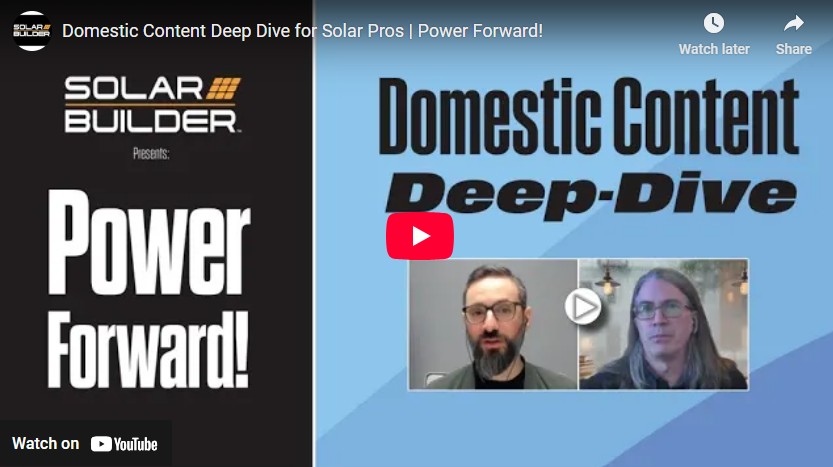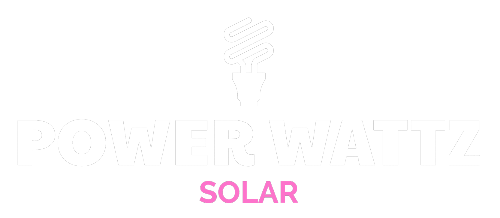
March 11, 2025
Domestic content is one of the most important topics in the solar industry, but what do solar contractors need to know about it right now? We go in-depth on the topic with David Dunlap, VP of product strategy at BayWa r.e., in the latest episode of Power Forward!
- 0:48 – Has the Trump Administration changed the domestic content outlook?
- 3:02 – Available U.S. solar manufacturing (modules, inverters, racking, batteries)
- 7:12 – Overview of changes to Safe Harbor Tables
- 9:38 – Is there value in sourcing a module with domestic wafers?
- 13:23 – MLPE vs. string cost percentage comparison
- 17:26 – How long can I use the May 2024 Safe Harbor Table?
- 19:24 – Changes to Energy Storage domestic content rules
- 22:29 – Does the DC percentage step up 5% each year for the ITC or no?
- 25:16 – What is the residential demand for domestic content solar products?
- 27:58 – Demand for domestic content in commercial solar?
- 29:06 – Is it just better to not pursue the domestic content tax credit?
Watch the in-depth “Domestic Content Deep Dive” episode in full right here. Or listen to the audio version in a podcast player of your choosing. Apple Podcast. Spotify. Podbean. Amazon.
Current landscape of domestic manufacturing for solar installers
Dunlap: “Across the categories, there’s been significant investment in the past few years moving in this direction, but it’s not complete and certainly not giving the breadth of choice in terms of manufacturers or product technologies that exists on the global stage.
“Inverters, we know that Enphase and SolarEdge started down this path much earlier than anybody else, and so they’re the ones that are going to be in the limelight and basically enjoy the market demand prominence by being first to market. … it remains to be seen who I think the next meaningful player might be. Obviously Tesla already manufactures a lot of their product in the U.S., but it’s a global company, and they’ve worked really hard to have the benefits of offshore manufacturing at different stages of the production in the supply chain. So we’ll see if they’re the next one.
“Racking, because of the way that the Safe Harbor Table turned the tide against the modules in favor of inverters and racking as a path last year in the May guidance, I think all the racking companies really jumped on that opportunity and said let’s spin this up, let’s make it happen. I think the delta between manufacturing a lot of the aluminum products versus importing offshore, maybe the gap wasn’t as big as with other categories, or the skill set requirement wasn’t as large of a gap. At any rate, I think the opportunity to replace imports with domestic is maybe greater, so we’re seeing pretty much all of the major racking companies have offerings, and they’re just working through all the different components and where they think they fall in the overall domestic content tax credit demand channels.
“Modules, we’ve really got three or four primary players that are ahead of the curve in terms of road mapping to having domestic cell manufacturing, but we’ve got a lot more than that that have U.S. factories for assembly. Then it just becomes a question of how much of the component products they can source domestically. Somewhere in that 3% to 12 / 13% range we probably could have a lot of opportunity, if it became a mandate, for example. Right now, you’ve got really Qcells, Silfab, Sirius PV, they are at the forefront of supporting the residential TPO part of this market. There are very few that are supporting it on the commercial side.
“On the batteries, that’s a tough one. We just don’t have the infrastructure in the supply chain to do full battery manufacturing in the U.S. I think it’s just going to take years to get there with enough volume and enough players, but we’re seeing the top players Enphase, SolarEdge, Tesla, FranklinWH, all have road maps to domestic content cell and cell pack manufacturing within this year.”
Understand more about the changes in the Safe Harbor Tables.
What is the demand for domestic content products right now?
Dunlap: “Honestly, it’s not as crazy as people say it is, or that they thought it might be. You’ve got pockets of high demand for certain products. Enphase, I guess, as the top inverter market share brand, and the obvious easy solution for installers who already installed Enphase, they just buy a slightly different SKU, they’re compliant under the prior guidance. So demand for certain things was spiking in those areas where those are attached to Sunnova lease sales because they were the first one to say it’s not just a choice, it’s a mandate.
“But then you look at Sunnova’s market share …
Pick up the rest of the conversation right there.
Tags: domestic content, Power Forward!
Source link

